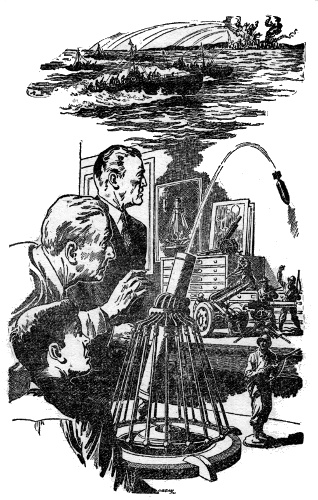
THE FINAL FIGURE
Novelet of the Day After Tomorrow
by Sam Merwin, Jr.
(illustrated by Paul Orban)
[Transcriber's Note: This etext was produced from Dynamic ScienceFiction January 1954. Extensive research did not uncover any evidencethat the U.S. copyright on this publication was renewed.]

The General had an unpleasant vision as he watched thismodel in operation....
The General was in mufti. He stood briefly within the entrance ofModels and Miniatures, Inc., feeling a mild envy of the civilians whobrushed past him, coming and going. They looked so easy, so relaxed, socasual in posture and dress. He was wistfully aware of the West Pointramrod that was his spine, the razor-edged bandbox neatness of hisbanker's grey suit, the Herbert Hoover four-squareness of his homburg,the stiff-symmetry of his dark-blue fore-in-hand.
He found compensation in visualizing some of these casual civilians inuniform—then shuddered, and moved on into the shop, poise and assurancerestored.
Save for the display-counters and wall-cases, the shop was softlylighted. And although it was well filled with customers and lookers ofall ages there was about it the hushed quality of a library—or achapel. Even the children talked softly as they pointed at and discussedthis 100-gauge English locomotive or that working jet-model of aVought-Chance Cutlass. They were well-aware of being in sight of wishand dream-fulfillment.
He moved slowly toward the rear of the shop, past the glass countersthat displayed gaily-painted models of carriages, coaches and earlyautomobiles; past the fire-engines in red and gold; past the railroads;past the planes and past the tiny ships—from Phoenician galleys andViking vessels with gaudily-decorative sails and shields to the latestbizarre-decked atomic aircraft carrier.
He stood in front of the miniature soldiers and, for a happy moment,recaptured the glamour of parades and gay uniforms that had beckonedhim into a career whose color and band-music had long since been wornoff by the nerve-wracking tragedy of battle and the endless ulceratingpaper-work of peace.
Busman's holiday, he thought. Sailors in a rowboat in Central Park.And he was glad he had not worn his uniform.
Each miniature-soldier manufacturer had a glass shelf to his own wares,labeled with a white-cardboard rectangle upon which his name had beenneatly brushed with India ink. Here were the comparatively rudeBritains, mass-produced, work-horses of toy armies throughout theWestern World since before his own boyhood.
Here were the heavy and magnificent Courtleys, specializing in medievalknights and men-at-arms, beautifully caparisoned in all the colors ofthe rainbow. Here were the Barker Napoleonics, the one-inch Staddens,the incredible half-inch Emery Penninsulars—each a costly little workof art that defied the enlarging of a magnifying glass. Here were Cometsin khaki and grey, perfect models of the guns, tanks and trucks ofAmerica, England and Soviet Russia.
To his left alo